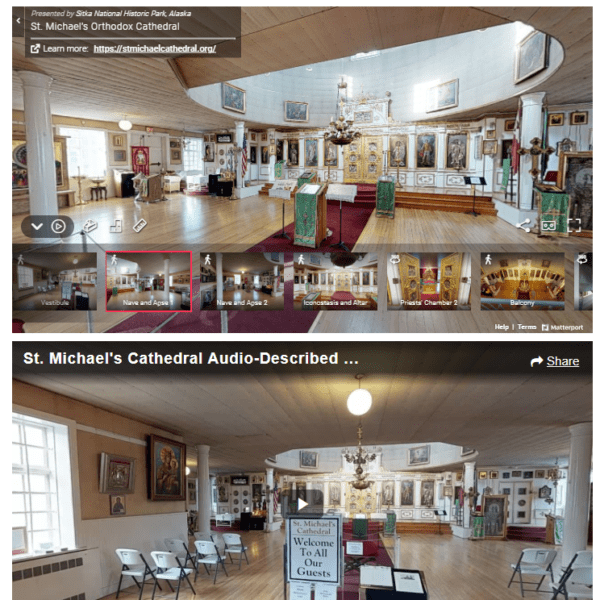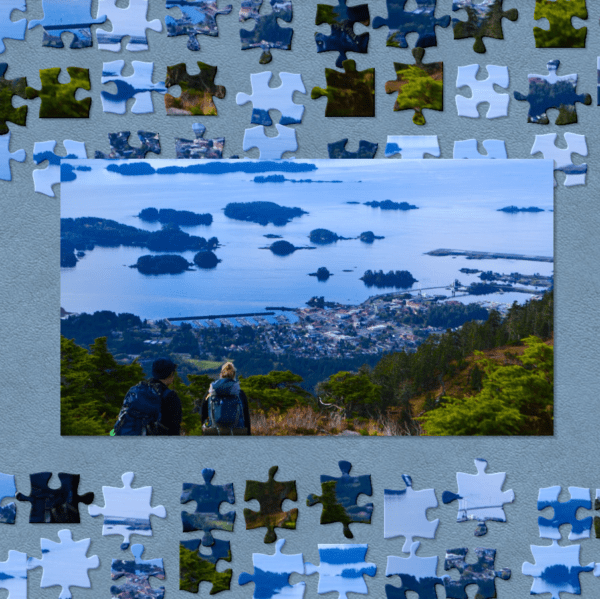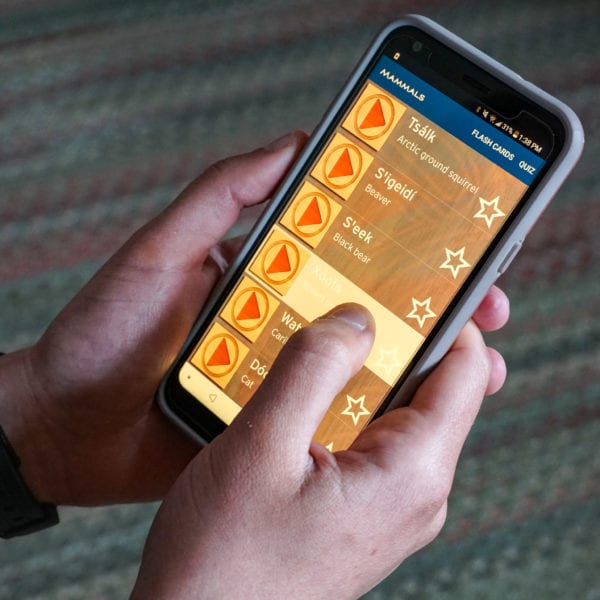No matter where you are in the world, you can experience Sitka from the comfort of your own home. We’ve compiled a list of different ways in which you can tour our town, learn about the local culture and history, and stay connected with us digitally:
1) Take a virtual tour
Thanks to the National Park Service, detailed virtual tours are offered for four historic Sitka sites: the Russian Bishop’s House, St. Michael’s Cathedral, Sheldon Jackson Museum, and Totem Trail.
By clicking on any of the links above, you can explore each of these buildings in highly-detailed 3D space, while listening to a comprehensive audio-described tour of these local attractions.
If you’re planning a visit to Sitka and want to check out local accommodations, both Wild Strawberry Lodge and Talon Lodge also have a detailed virtual tour on their websites to give you a better feel for the space and lodging.

Screenshot of the virtual tour offered at St. Michael’s Cathedral
2) Watch 14 Miles
Produced by local nonprofit ArtChange, Inc, 14 Miles is a film series about Sitka, Alaska featuring 32 micro-documentaries; most of the episodes are around five minutes long.
“14 Miles is also an experiment in short-form storytelling,” writes filmmaker and ArtChange, Inc. director Ellen Frankenstein, “Serious, wry, curious: we’re digging and uncovering what might get passed by, even in a remote town with only 14 miles of road from one end to the other. The stories we want to share are local, but also universal. 14 Miles will share how this place connects, and at times doesn’t, to the world ‘off the rock’”.
This episode, “Captain Gary”, features one of our wildlife viewing operators, Cpt. Gary’s Sitka Adventures.
3) Explore online art exhibits
The Alaska State Museum has a concise online exhibit featuring local artist Tommy Joseph. “Rainforest Warriors” offers a glimpse into the Tlingit master carver’s body of work and personal collection.
Through the Estate of Dale DeArmond, you can also view hundreds of the late artist’s woodcut prints digitally.
4) Complete an online jigsaw puzzle
We’ve created some Sitka-themed jigsaw puzzles on Jigsaw Explorer. Try out a view of Sitka from Japonski Island, the details of a totem pole, or this phenomenal shot of Sitka Sound. You can customize the number of pieces, for whether you’re helping a small child or up for a 1040-piece challenge.

Screenshot of one of our puzzles, featuring Sitka and Sitka Sound
5) Drive from one side of town to the other
We love this video by the Youtuber Ben Dever; Ben spent an afternoon filming his drive from one end of town to the other. Sit back, put the video in fullscreen, and enjoy a relaxing drive through town.
6) Add to your reading list
Whether you prefer fiction or nonfiction, consider picking up a book that takes place in Sitka. Winner of the Shamus Award, local author John Straley’s novel The Woman who Married a Bear is a brooding murder mystery set in Sitka.
The Yiddish Policemen’s Union by Michael Chabon is a science fiction and alternative history book reimagining a timeline where Sitka, Alaska became a temporary settlement for Jewish refugees during World War Two.
For a memoir about life in southeast Alaska, look for books by Ernestine Hayes, like The Tao of Raven and The Blonde Indian. Hayes is a Tlingit writer and professor at the University of Alaska Southeast, and a member of the Kaagwaantaan (Wolf) House. Her memoirs, essays, and poems explore identity, culture, colonialism, and the environment.
7) Experience the wonder of our natural scenery
Mattieu Petit, a French cinematographer, created a short video called “Alone in Alaska” about his time in Sitka and Juneau. He has some truly breathtaking shots of Sitka’s natural scenery and wildlife, and captures his adventures both on land and in water!
You can also check out our video “A Walk in Time” for more shots of our town and wildlife.
8) Practice your Tlingit
Sealaska Heritage Institute is a Native nonprofit organization dedicated to perpetuating and enhancing Tlingit, Haida, and Tsimshian cultures of Southeast Alaska.
SHI offers two Tlingit language learning apps free to download for iOS and Android devices. Through the Learning Tlingit app, you can listen to audio recordings for hundreds of vocabulary words in over twenty categories. The Tlingit Language Games app, meanwhile, teaches vocabulary words through interactive gameplay.

Practicing vocabulary on the Learning Tlingit app
9) Listen to the sounds of Sitka
Listen to some of our local radio stations online, like KCAW and KIFW, for carefully-curated playlists and regional updates.
For more ambient background noise, we love this “Pacific Northwest” ambient mixer by Sam Hain. Control different audio elements, such as wind, birds, and waterfalls, to transport yourself into the Tongass.
10) Watch The Salmon Forest and complete the educational packet
The Salmon Forest is a 30-minute documentary film produced by the U.S. Forest Service, the Sitka Conservation Society, and Wild Agency, featuring the connection between wild salmon and life in Alaska’s Tongass National Forest. The documentary is free for online streaming, and you can download an additional educational packet which includes a coloring page by local artist Hannah Hamberg.
11) Bring a taste of Alaska to your kitchen
Even if you can’t make it out to a private island, you can still have a bite of luxury from home. Talon Lodge publishes a list of online recipes from their lodge, featuring a variety of seafood dishes from different global cuisines. Make a dish of Spanish-style rockfish with corn fritters and saffron aioli in a chorizo-tomato broth or a plate of miso-marinated sablefish.
12) Learn some maritime history
The Sitka History Museum offers a text-based online exhibit called “Investigating the Wreck of the Neva”, a Russian-American Company ship which sank off Kruzof Island in 1812.
To learn more about Alaska’s maritime history, consider signing up as a digital volunteer for the National Oceanic and Atmospheric Administration’s Old Weather project. You will transcribe 19th and 20th-century ship logs, helping advance climate change-related research and historical records.
